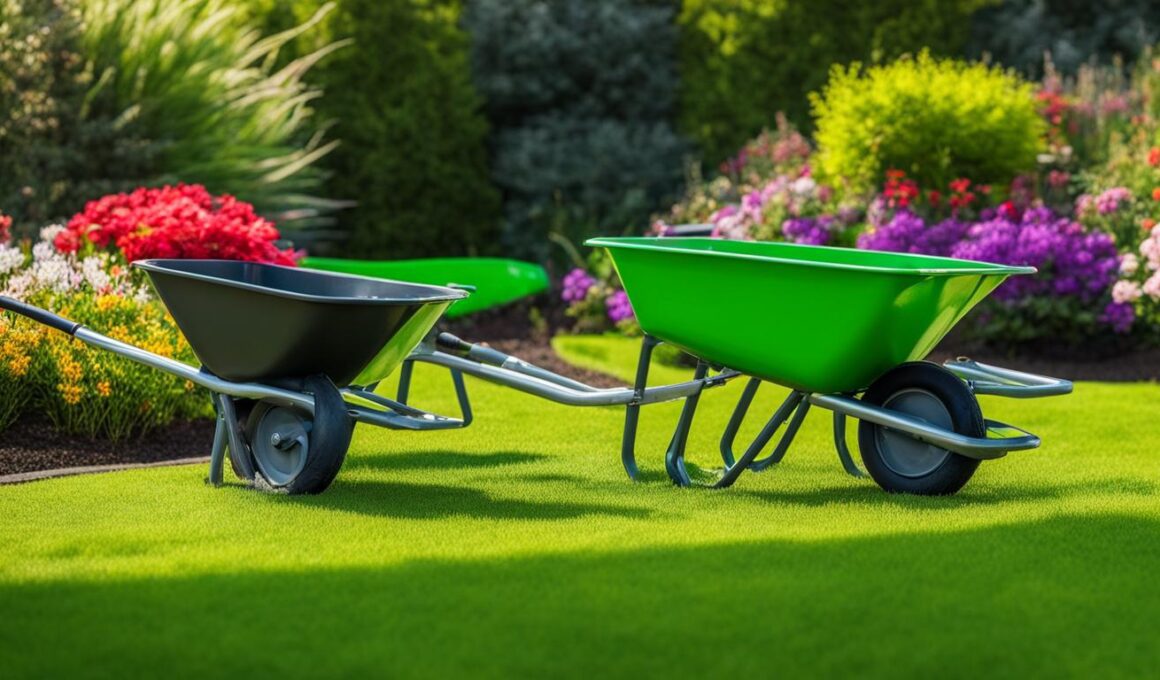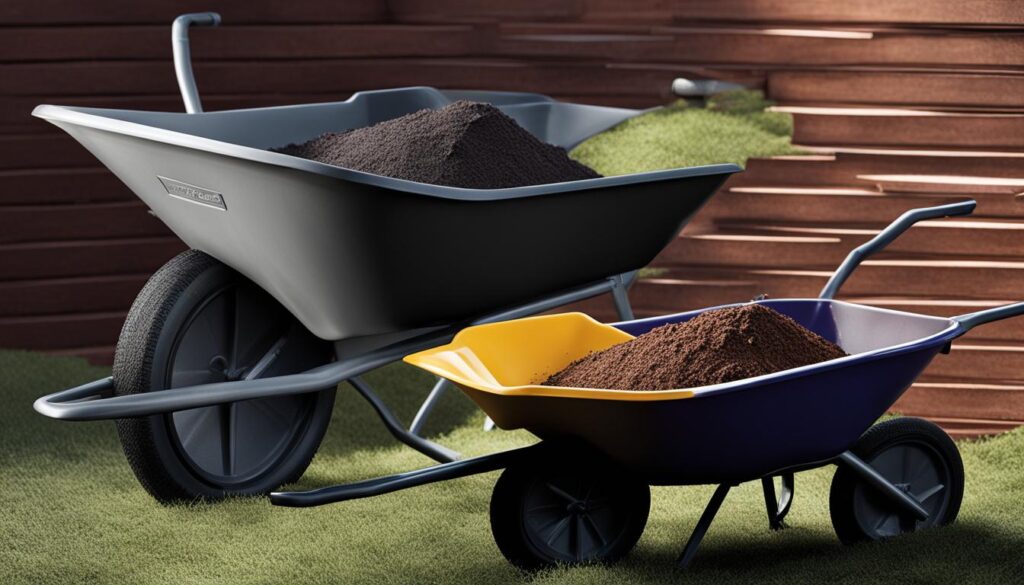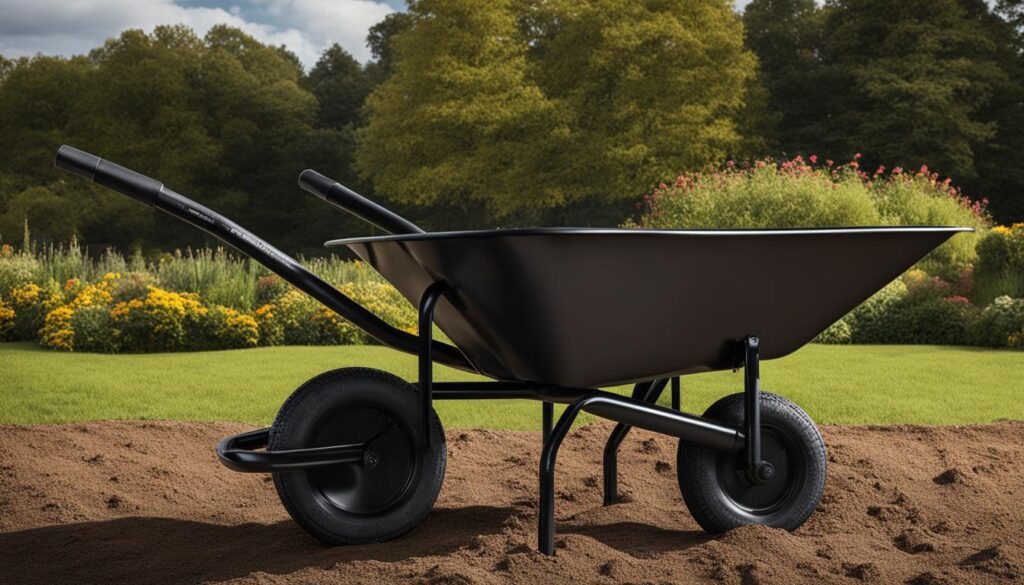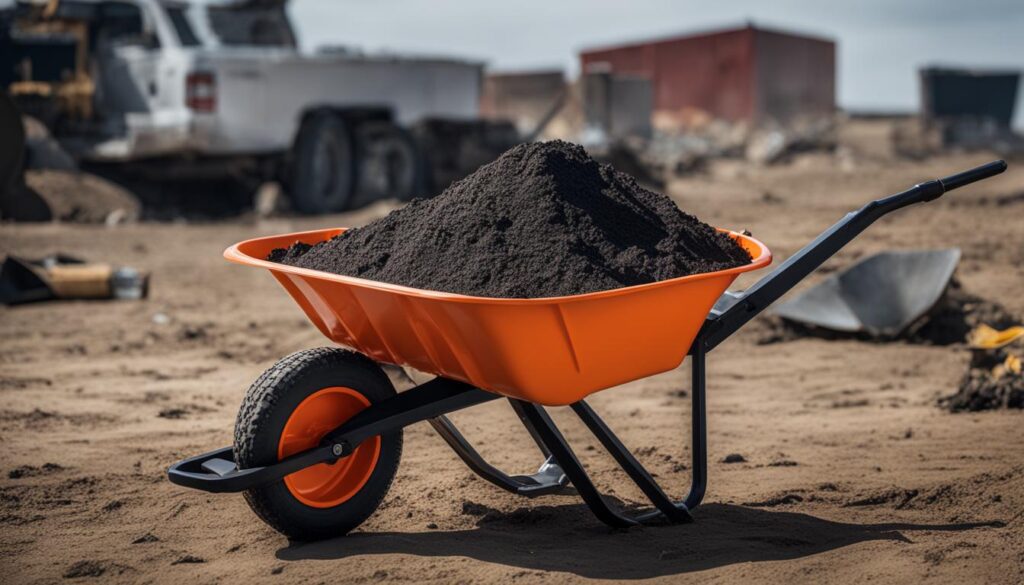Wheelbarrows are essential gardening tools for simplifying tasks such as planting, maintenance, and hauling. Available in multiple materials, primarily plastic and steel, they cater to various gardening and construction needs. Plastic wheelbarrows are known for their lightweight nature, affordability, and resistance to rust, making them suitable for carrying lighter garden materials. On the other hand, steel wheelbarrows provide sturdiness and durability to handle heavy loads like building supplies or dense organic materials, despite being prone to rust if not maintained properly. In this article, we will help you compare your options to find the best match for your specific outdoor work requirements.
Key Takeaways
- Plastic wheelbarrows are lightweight, affordable, and rust-resistant, ideal for lighter gardening tasks.
- Steel wheelbarrows can handle heavy loads and offer increased durability, but require proper maintenance to prevent rust.
- Consider factors like material flexibility, ground resistance, and your physical ability when choosing between plastic and steel wheelbarrows.
- Both plastic and steel wheelbarrows come in various sizes and designs to suit different gardening and construction needs.
- Evaluate your workload, type of materials being transported, maintenance requirements, and comfort preferences when selecting the optimal wheelbarrow material for your outdoor projects.
Evaluating Wheelbarrow Materials: Plastic and Steel Compared
The choice between plastic and steel wheelbarrows hinges on the balance between maneuverability and sturdiness. Both materials can offer unique advantages and challenges when it comes to outdoor tool selection. In this section, we will dive deeper into the key factors to consider when evaluating wheelbarrows, including material flexibility, resistance to ground resistance, and the user’s physical ability to manage the wheelbarrow’s weight.
- Material Flexibility
- Plastic Wheelbarrows: These lightweight garden carts provide ease of use and resistance to weather-induced brittleness. Ideal for transporting less dense materials, plastic wheelbarrows are a popular choice for gardeners who need to maneuver around tight spaces with minimal exertion.
- Steel Wheelbarrows: Recognized for their historical presence in yards and construction sites, steel wheelbarrows boast superior load-bearing capacity without buckling under heavy weights. However, they can be heavier and harder to maneuver compared to their plastic counterparts.
- Plastic Wheelbarrows: These carts are often designed with wider, flat-bottomed trays for improved stability on soft or uneven terrain. Their relatively lightweight nature also makes them less likely to sink into the ground.
- Steel Wheelbarrows: Steel wheelbarrows typically feature thinner, more rounded trays, which may provide better ground penetration. Nonetheless, users should take care not to overload the wheelbarrow when working on uneven terrain, as weight distribution can become unbalanced.
- Plastic Wheelbarrows: Since they tend to be lighter than steel wheelbarrows, plastic carts minimize physical strain and can be ideal for users with limited strength or mobility.
- Steel Wheelbarrows: Carrying heavier loads can make steel wheelbarrows challenging to manage for some users, particularly over long distances and on challenging terrain.
To further help you understand the differences between plastic and steel wheelbarrows, the following table illustrates a side-by-side comparison of each material’s characteristics:
| Characteristic | Plastic Wheelbarrow | Steel Wheelbarrow |
|---|---|---|
| Weight | Lightweight, easier to maneuver | Heavier, may require more strength to operate |
| Durability | Resistant to rust, but susceptible to cracks and punctures | Highly durable yet prone to rust if not properly maintained |
| Flexibility | Flexible tray material, can handle lighter loads | Rigid tray material, ideal for heavy-duty loads |
| Maintenance | Minimal care required | Requires regular maintenance to prevent rust |
Ultimately, the right wheelbarrow for your needs will depend on your own preferences, the tasks you need to complete, and the garden equipment durability you require. By considering the factors outlined in this section, you can make a more informed decision when choosing between a plastic and steel wheelbarrow.
The Lightweight Champion: Advantages of Plastic Wheelbarrows
Cost-Effectiveness and Maneuverability
Plastic wheelbarrows are known for their affordable prices and easy maneuverability, making them a popular choice among gardening enthusiasts. Due to their lightweight construction, they are easier to handle, especially when navigating tight corners or uneven terrain in your garden. Furthermore, the reduced shipping costs associated with their weight add to their overall cost-effectiveness.
Longevity and Weather Resistance
Plastic wheelbarrows are not only durable, but they are also weather-resistant, ensuring your investment in garden equipment lasts a long time. Made from high-quality plastic materials, they can withstand exposure to extreme weather conditions without becoming brittle. However, it is essential to note that prolonged exposure to the sun or cold temperatures may lead to material degradation over time.
Variety of Sizes and Designs in Plastic Wheelbarrows
One of the advantages of choosing a plastic wheelbarrow is the versatility in sizes and designs available to suit your gardening needs. From jumbo to compact models, there is a plastic wheelbarrow for every task, whether it’s hauling light garden trimmings or bags of soil. Moreover, these wheelbarrows come in various colors and styles that cater to different preferences and aesthetics.
| Wheelbarrow Size | Capacity | Typical Use |
|---|---|---|
| Jumbo | 10-12 cubic ft | Heavy-duty tasks, large volume materials |
| Standard | 6-8 cubic ft | Medium-duty tasks, general gardening |
| Compact | 3-5 cubic ft | Small tasks, tight spaces, light materials |
In summary, plastic wheelbarrows offer a range of benefits that make them an attractive choice for gardeners seeking a lightweight, affordable, durable, and weather-resistant garden tool. With various sizes and designs available, finding the perfect plastic wheelbarrow to fit your gardening requirements has never been easier.
The Heavy-Duty Contender: Benefits of Steel Wheelbarrows
When dealing with demanding gardening or construction tasks, a heavy-duty steel wheelbarrow might be the ideal choice. Steel wheelbarrows are distinguished by their robust construction, making them suitable for carrying substantial weight without compromise.
Despite their heaviness, steel wheelbarrows offer unparalleled durability, positioning them as a stalwart option for tasks that involve abrasion and significant stress. However, users need to be cautious of their greater weight and the necessity for maintenance to prevent rust. In the following sections, let’s explore the benefits of industrial-grade wheelbarrows and durable construction wheelbarrows.
Handling Heavy-Duty Tasks with Ease
Steel wheelbarrows excel at managing tasks that require the transportation of heavy materials, such as logs or cement. The strength and structural integrity of these wheelbarrows allow them to withstand substantial loads without distortion or failure.
Durability and Sturdiness
One of the key benefits of steel wheelbarrows is their long-lasting durability. They are designed to endure harsh conditions and rigorous use, which makes them ideal for both gardening and industrial settings. A well-built steel wheelbarrow can withstand the test of time and resist damage, thanks to its durable construction.
Improved Load Security
A steel wheelbarrow provides improved load security compared to its plastic counterpart. The weight of a steel wheelbarrow, although heavier, offers additional stability, ensuring that your cargo remains securely in place as you transport it across uneven or sloping terrains.
Maintenance Considerations
- Preventing Rust: To maintain the integrity and longevity of your steel wheelbarrow, ensure it is kept dry and protected from rain, snow, and humidity.
- Lubricating Moving Parts: Regularly lubricate essential components, such as the wheel axle, to minimize wear and tear and guarantee smooth operation.
- Inspecting and Replacing Components: Regularly inspect your steel wheelbarrow for signs of damage or wear, and replace or repair parts as needed to keep it in optimal condition.
In conclusion, steel wheelbarrows are highly suited for handling robust tasks, thanks to their heavy-duty construction and durability. By selecting the correct wheelbarrow and following the appropriate maintenance precautions, you can ensure that your steel wheelbarrow performs to its fullest potential for years to come.
Practical Considerations: Which Wheelbarrow Suits Your Work Best?
When selecting a wheelbarrow, it is crucial to consider several factors that can significantly impact its performance and longevity. These factors include the wheelbarrow load capacity, the job it will be used for, and the user’s physical ability to handle it.
Hauling Capacity and Job Type
The appropriate wheelbarrow load capacity depends on the type of job it will be used for and the materials being transported. Plastic wheelbarrows are best suited for lighter and voluminous materials, while steel wheelbarrows are ideal for handling heavy and dense objects.
| Type of Wheelbarrow | Load Capacity | Best Suitable For |
|---|---|---|
| Plastic Wheelbarrow | Lighter load capacity | Garden trimmings, grass clippings, leaves, and small amounts of soil/compost |
| Steel Wheelbarrow | Higher load capacity | Bricks, logs, cement bags, large amounts of soil/compost, and construction materials |
Maintenance and Durability Concerns
Maintaining your wheelbarrow directly influences its long-term durability. Plastic wheelbarrows require minimal maintenance but can be subject to material degradation when exposed to prolonged sunlight and extreme cold. On the other hand, steel wheelbarrows demand regular care to prevent rust, including protecting them from rain and snow.
- Plastic wheelbarrow maintenance: Clean after use and store away from direct sunlight.
- Steel wheelbarrow maintenance: Clean after use, check for rust regularly, and apply a rust inhibitor or paint if needed.
Comfort and Ease of Use
An ergonomic wheelbarrow design is essential for comfortable use and safe operation. Plastic wheelbarrows tend to be lightweight, reducing strain and improving maneuverability. In contrast, steel wheelbarrows are heavier, provide stability, and can support the transport of heavier loads. Personal health conditions, such as back problems, can influence the choice toward lighter and more manageable wheelbarrows.
- Weight: Consider the weight of the wheelbarrow itself and the materials being transported.
- Handle design: Look for ergonomically designed handles that promote a comfortable grip and reduce stress on wrists and shoulders.
- Wheel type: Choose between single and dual wheel designs based on the terrain and maneuverability requirements.
When selecting a suitable wheelbarrow for your job, it is vital to consider its load capacity, material durability, and ergonomic design. Balancing these factors will help ensure a comfortable and efficient wheelbarrow experience tailored to your specific needs.
Which Type of Wheelbarrow is Best for Planting Mums in the Ground?
When it comes to planting mums in the ground, a two-wheel wheelbarrow is the best option. This type of wheelbarrow provides better stability and control, making it easier to maneuver through the garden and transport soil, mulch, and plants for your gardening project.
Conclusion
Ultimately, selecting the best wheelbarrow choice comes down to your specific needs and circumstances. Both plastic and steel wheelbarrows offer distinct advantages that cater to different gardening tasks and requirements. The key lies in determining which type will serve you the best, both in terms of usability and durability.
For lighter gardening work, plastic wheelbarrows present an affordable and easy-to-maneuver option. They are particularly well-suited to tasks requiring a rust-resistant and weather-resistant solution. On the flip side, steel wheelbarrows are ideal for heavy-duty materials and rough handling. Though they may require more maintenance to prevent rust, their sturdiness and stability are unparalleled for intense jobs.
When making your garden wheelbarrow selection, keep in mind the workload and type of materials you will be transporting, as well as the necessary maintenance and your ergonomic needs. By taking all of these factors into consideration, you can ensure that you choose the optimal wheelbarrow material and design to efficiently and effectively enhance your outdoor work experience.











